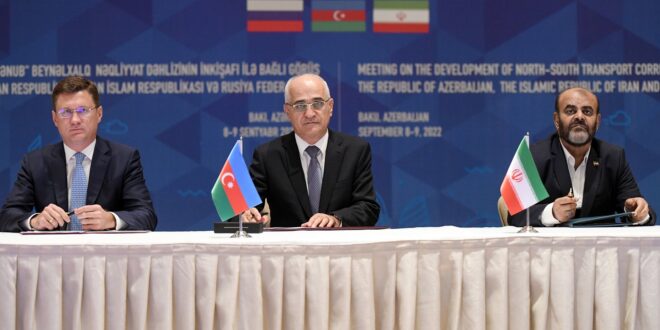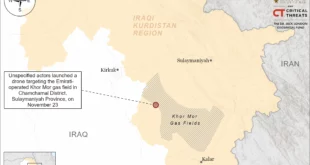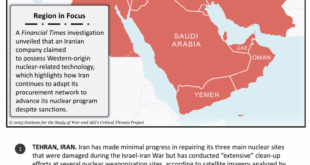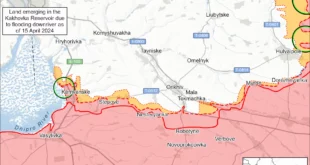The 164 km Rasht-Astara railway route in Iran’s Gilan Province is of great importance in the International North–South Transport Corridor (INSTC), because it is the only remaining rail part of this corridor, writes Valdai Club expert Vali Kaleji.
In his article, Dr. Vali Kaleji, a Tehran-based expert on Central Asia and Caucasian Studies, postulates that after the First Karabakh War, Iran’s railway connection with the Caucasus was cut and this unfortunate situation has not changed in three decades. Among the proposed bilateral or multilateral rail projects to overcome the rail and transit gap, the 164 km Rasht-Astara railway route in Gilan Province of Iran is of great importance in the International North–South Transport Corridor (INSTC), because it is the only remaining rail part of this corridor. Given Azerbaijan’s decision not to expose itself to the effects of U.S. secondary sanctions by providing its share of the agreed investment, Tehran turned to Moscow for support. The conflict in Ukraine, the extensive Western sanctions against Russia, Russia’s transit restrictions to Eastern Europe, the “Preferential Trade Agreement” (PTA) between Iran and the Eurasian Economic Union (EAEU), and increasing trade and transit between Russian and India, has caused attention in the INSTC to be more serious than in the past; the 164- km Rasht-Astara railway is an important part of it. In the latest development, Russian presidential aide and State Council Secretary Igor Levitin visited this rail route on January 18, 2023. According to the agreement between the two countries, with the investment of the Russians, the rail project is supposed to be completed within 3 years and will connect to the railway of Azerbaijan’s Astara that was built in 1941 as a part of the Soviet railway network.
After the First Karabakh War, the regions of Fuzuli, Jabrayil and Zangilan near the Iranian border came under Armenian control and the railway connection between Nakhichevan and mainland Azerbaijan was severed. While the northern railways from Armenia to Georgia and Azerbaijan to Russia continued to operate, Iran’s railway connection with the Caucasus was cut and cargo exchanges through this border dropped sharply”. “This unfortunate situation has not changed after three decades, and, despite the high volume of trade and travel, Iran does not have a direct rail connection with the Caucasus region. In fact, “while to the east of the Caspian Sea there is a working railway route from Russia through Kazakhstan and Turkmenistan to Iran, along the western shore of the Caspian, in the South Caucasus region, the linked railway networks of Russia and the Republic of Azerbaijan still lack a physical connection with Iran.”
This has had a very negative impact on the volume and pace of trade with the Caucasus countries as well as with Russia, causing, inter alia, heavy traffic on both sides of the land borders, including the Astara-Astara (Iran-Azerbaijan) and Noruduz-Meghri (Iran-Armenia) border crossing points. Over the last two decades, Iran, Armenia, Azerbaijan, and Russia have each proposed bilateral or multilateral rail projects to overcome the rail and transit gap. The construction of the 164 km Rasht-Astara railway, the 55 km Zangilan-Nakhchivan railway line through Iranian territory and the revival of the Soviet-era railway (Jolfa-Nakhchivan) are main important rail projects that regretfully have not yet been fully completed.
Among the unfinished railway projects mentioned, the 164 km Rasht-Astara railway route is of great importance in the International North–South Transport Corridor (INSTC), because it is the only remaining rail part of this corridor and is the missing link in what would be a direct rail link from the Persian Gulf to Moscow and St. Petersburg. On one hand, in 1941 the Soviet railway network was extended southwards to Astara, Azerbaijan, located at the southern border with Iran, across from an identically-named city in that country. Therefore, the railway route from Moscow and St. Petersburg to Astara in the Republic of Azerbaijan on the Iranian border has been active since 1941. On the other hand, there was a rail gap inside of Iran, between Astara, Gilan Province (Iran) and Qazvin, located 150 km (93 mi) northwest of Tehran, in Qazvin Province.
For this reason, in 2002 as a 7,200-kilometer-long multi-modal network of ship, rail, and road routes was created within the framework of the INSTC. “The first joint effort was made between Iran, Azerbaijan, and Russia to connect the Iranian railway network to the Caucasus region. The three parties signed an agreement on constructing the route in 2005, building on a Soviet extension of the railway southwards to Astara in Azerbaijan, at the southern border with Iran. As mentioned before, in 1941 the railway line was also extended southwards to Astara, located at the southern border of Azerbaijan with Iran. Therefore, in order to establish the rail contact, it was necessary to build a railway from Astara to Rasht and Qazvin in Iran”. Construction of the Rasht-Qazvin railway started in 2009 and took nearly a decade to complete. The following map clearly shows the route of the Ghazvin- Rasht Railway in Gilan Province of Iran.

The route of the Ghazvin- Rasht–Astara Railway southwest of the Caspian Sea
However, “construction of the Rasht-Astara railway has, unfortunately, faced serious problems. Therefore, “given Iran’s practical need for the construction and completion of the Rasht-Astara railway on the one hand, and Azerbaijan’s decision not to expose itself to the effects of U.S. secondary sanctions by providing its share of the agreed investment (a $500 million loan for this purpose) on the other, Tehran has turned to Moscow for support. “Tehran has sought to utilise this situation, stepping up efforts to attract Russian investment in the Rasht–Astara railway project.”
In this regard, it was reported that during President Ebrahim Raisi’s visit to Moscow in January 2022, the two sides finalised a previously agreed-upon $5 billion credit line for the completion of several development projects in Iran. As noted by the Iranian Minister of Economy, Ehsan Khandouzi, the Rasht-Astara railway “is one of the projects covered by the Russo-Iranian agreement”. The following map clearly shows the route of the Ghazvin- Rasht–Astara Railway to the southwest of the Caspian Sea.
But following “the conflict in Ukraine and the extensive Western sanctions against Russia, has caused attention to be more serious than in the past to the INSTC that the 164- km Rasht-Astara railway is an important part of it. In this circumstances, “Iran is seeking Russia’s financial support for the project which is estimated to cost 800 million euros, according to latest estimates by the Iranian government”. In this regard, “Rostam Qassemi, former Iranian Minister for Roads and Urban Development, visited Moscow on April 30, 2022. Following his talks with the Russian Transport Minister Vitaly Savelyev, the two officials signed a comprehensive agreement on cooperation in the field of transportation including complete the missing Rasht-Astara portion of the INSTC”. In the latest development signifying growing regional prioritisation of the 164- km Rasht-Astara railway and the INSTC more broadly, Russian presidential aide and State Council Secretary Igor Levitin, accompanied by the senior railway officials of Iran, inspected the proposed track route by helicopter on January 18, 2023.
Following this visit and “according to the agreement between two countries, with the investment of the Russians, the rail project is supposed to be completed within three years, which is one year less than the forecast made and Iranian contractors will fully implement the infrastructure of the railway line”. Since 12 km of the construction of the Rasht-Astara railway line was done by the Iranian contractor, it will need to finish the 152-kilometer railway line with Russian financing. But what is the importance and necessity of the rapid construction and completion of the Rasht-Astara railway project? Why do Iran and Russia have to cooperate with each other in this project? In order to answer these questions, the following important points and considerations are worth noting:
- Following the first trilateral meeting of Iran, Azerbaijan, and Russia on the prospects of the INSTC on September 8, 2022 in Baku, the parties signed a trilateral statement for the development of the INSTC. The countries agreed to increase freight transit through the INSTC to 30 million tonnes by 2030. Indeed, “trade turnover between Russia and Iran during January-October 2022 surpassed trade volumes during the whole of 2021 and totalled $4 billion, Russian exports to Iran increased by 27%, while imports hiked by 10%, the deputy head of FCS, Vladimir Ivin, told the publication”. Since the major part of Iran’s trade with Russia takes place from the western, more densely populated part of this country, including the cities of Moscow, Saint Petersburg, Kazan, Rostov and the North Caucasus, the main route of trade and transit between the two countries necessarily passes through the Republic of Azerbaijan. Given these circumstances, the lack of the 164-kilometer Rasht-Astara rail route has had a very negative impact on the volume and pace of trade along the main transit route between Iran, Azerbaijan and Russia, especially at the “Astara-Astara border crossing”. From here, via the 287 kilometre Astara-Baku national highway, trucks and containers are transported to Azerbaijan and Russia.
On average, a truck only crosses the Astara border every 7 minutes. This issue causes heavy traffic and in some cases disruptions and long stops at the Astara (Iran)-Astara (Azerbaijan) border crossing, as well as the Samur border crossing on the border of Azerbaijan and Russia, that reduced the volume and speed of the transfer of goods via the corridor. The stoppage and several kilometre-long queues of trucks at the border crossing of Astara in January 2023 is the latest example of the problems at this border crossing. In fact, the increase in the volume of export, import and transit of goods, in a situation where there is only one 80-year-old metal border bridge between the two countries, has caused long queues of trucks and trolleys at the Astara border. To solve this problem, Iran and Azerbaijan signed a MoU on January 26, 2022 to build the new “Astarachay bridge” with four lanes that can facilitate the process of transit between the two countries.
However, despite the construction of this bridge, the problem of traffic and long stops of trucks at the border terminals of Astara-Astara and Samour will not be completely solved. There are two solutions to this problem. First, expanding maritime trade and transit between Iranian ports in the Caspian Sea (Astra, Anzali, Caspian, Nowshahr, and Amirabad) with Baku port in Azerbaijan, as well as Makhachkala, Olya, Astrakhan, Solyanka and Lagan – the main Russian ports in the Caspian Sea. It could reduce part of the traffic load of the land route in Astara-Astara-Baku-Dagestan. The second solution is construction of the 164-kilometer Rasht-Astara rail route that will reduce the time needed to transport cargo from Russia to Iran’s southern ports on the Persian Gulf and on the Sea of Oman by 20 days.
- The lack of this railway connection has made it inevitable that freight trains at the Astara railway station on the Iranian side will be transferred to trucks, or vice versa. It is clear that this slows down trade and transit between Iran-Azerbaijan-Russia. If the 164-kilometer Rasht-Astara rail route is completed, cargoes and containers from Moscow and St. Petersburg can be transported directly and non-stop to Bandar Abbas in the south of Iran in the Persian Gulf. On the other hand, the goods imported by Russia from India, Arab countries and Iran can also be transferred to the Republic of Azerbaijan and Russia with speed, low cost and high volume from the southern ports of Iran in the Persian Gulf. But as mentioned before, at the present time the 164-kilometer Rasht-Astara rail route is the only remaining rail part of the INSTC and is the missing link for the direct rail link from the Persian Gulf to Moscow and St. Petersburg.
- Another important necessity of construction in the 164-kilometer Rasht-Astara rail route is “EAEU -Iran Preferential Trade Agreement” (PTA), which was implemented on October 27, 2019 and can be upgraded to to a full Free Trade Agreement. It is expected to become operational by late September 2023 after being approved by the IAEA member countries”. Since the Free Trade Agreement involves more than 7,500 types of commodities, it is obvious that this trade regime naturally need to more rapid and extensive in facilitating the movement of goods between Iran and the EAEU —especially with the Russian Federation. Given these circumstances, there is no doubt that the land route of Astara- Astara- Baku- Dagestan cannot go ahead with the increasing volume of Iran’s exports and imports with the EAEU, especially Russia. The stoppage and queue of several kilometres of trucks at the border crossing of Astara in January 2023 was a serious alert for Iran, Azerbaijan and Russia. Therefore, in the process of free trade, in parallel with the development of the land route and border terminals as well as sea trade in the Caspian Sea, the construction and completion of the 164-kilometer Rasht-Astara rail route should be considered as a strategic and important priority for Tehran, Baku and Moscow. Streamlining and facilitating trade and transit is for the benefit of all three countries and there is no loser in this process.
- Two complementary rail lines for the Rasht-Astara rail line are under construction in the north and south of Iran. First, the 35-km Rasht-Caspian railway in Iran’s northern Gilan Province to the Caspian port, which is a seaport located in the Anzali Trade-Industrial Free Zone. If the 164 km Rasht-Astara railway is completed, Astara port in Gilan province will also be connected to the Iranian rail network. At the present time, construction work has been completed on the first 11 km of the 35 km stretch of the Rasht-Caspian railway line and the remaining 24 km should be completed in 2023. The second complementary rail line is the 628-kilometer railway project, which is aimed to connect Chabahar port to Zahedan (the capital city of southeastern Sistan-Baluchestan Province). Iran hopes it can be completed by the end of the calendar year 1402 (March 20, 2024). If the 164 km Rasht-Astara rail route and the 625 km Chabahar-Zahedan rail route are built and completed, it will be possible to transfer cargo and containers from Chabahar port – as the “only ocean port” of Iran – directly to the Republic of Azerbaijan and Russia. Currently, due to the non-completion of the Chabahar-Zahedan railway route, there is a possibility of exporting and importing from Bandar Abbas, which is connected to Iran’s railway network. The Location map of the Chabahar port is depicted on the map below.

The 628-kilometer railway project between the Chabahar port to Zahedan (the capital city of south-eastern Sistan-Baluchestan Province)
- Construction of the 164-kilometer Rasht-Astara rail route is very important in transit and trade between India, Iran and Russia, the three courtiers which founded the INSTC on May 16, 2002. Indeed, India has a key role in the Chabahar Transit Project that was created among India, Iran, and Afghanistan on May 24, 2016; recently Uzbekistan joined it. Although India has always been one of Russia’s main trading partners, according to trade, transit and financial sanctions levied against Russia by the West, the volume of trade and transit exchanges between India and Russia has increased significantly. Given these circumstances, Iran’s rail network connected to Bandar Abbas is one of the most important transit options in India, which can transport goods to Rasht in the north of Iran. However, the lack of the 164-kilometer Rasht-Astara rail route causes the trains at the Rasht railway station to transfer goods to trucks, and vice versa in Astra, Azerbaijan. Therefore, the non-completion of this rail route is considered an inhibiting factor in the development of trade and transit between India and Russia, especially given the current situation.
In general, although the 164 km Rasht-Astara rail route is comparatively short, it has great strategic and transit importance. It can play a very important role in increasing trade and transit between India, Iran, Azerbaijan and Russia. This rail route can also connect Bandar Abbas and other Iranian ports in the Persian Gulf to Russia, especially Moscow and St. Petersburg., that can lead to increasing trade and transit between Arab countries such as the United Arab Emirates, Qatar and Oman and Russia. Completion of the 164 km Rasht-Astara rail route, as the only remaining rail part of the INSTC, will help this corridor achieve its desired goals of creating a “multifaceted corridor” and “combined network” of ships, rails, and road freight routes, two decades after its formation in 2002.
 Eurasia Press & News
Eurasia Press & News



